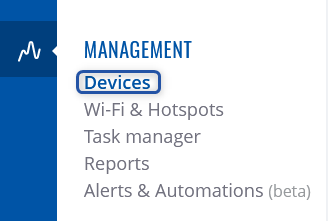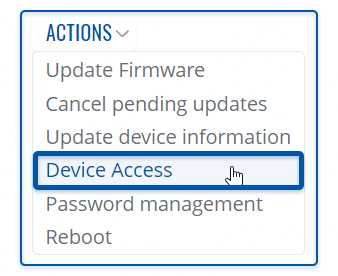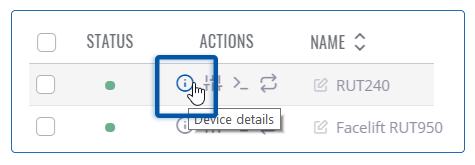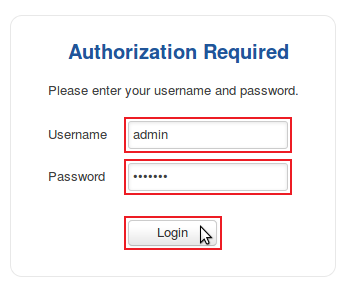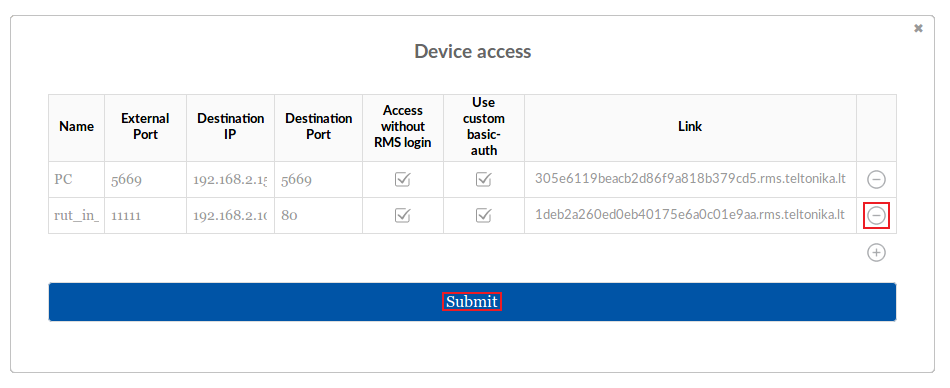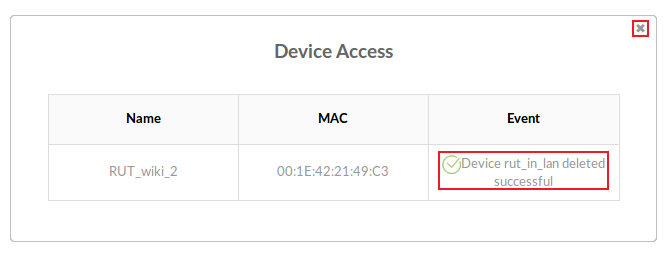Difference between revisions of "Template:Rms manual management commands access"
From Teltonika Networks Wiki
| (16 intermediate revisions by 2 users not shown) | |||
| Line 1: | Line 1: | ||
| − | To configure device access go to the RMS web page, Left sidebar panel, (<b>Management → | + | To configure device access go to the RMS web page, Left sidebar panel, (<b>Management → Overview</b>) and click on <b>Overview</b> submenu. |
| − | Move your mouse pointer to the Top control '''Actions''' menu and select ''' | + | Move your mouse pointer to the Top control '''Actions''' menu and select '''Access''' (Actions → Access). |
[[File:RMS-device-menu-left-sidebar-panel.jpg]] [[File:RMS-top-menu-actions-access.jpg]] | [[File:RMS-device-menu-left-sidebar-panel.jpg]] [[File:RMS-top-menu-actions-access.jpg]] | ||
| + | |||
| + | The '''Access''' function provides you with the possibility to set up remote HTTP access to devices that are connected to a device's LAN, provided that the device in question has been registered to RMS. | ||
| + | |||
| + | [[File:RMS-how-to-use-Access.gif]] | ||
<br> | <br> | ||
| Line 9: | Line 13: | ||
---- | ---- | ||
# Make sure that the device for which you would like to set up remote access is physically connected to the router's LAN or WAN (depends on your configuration). | # Make sure that the device for which you would like to set up remote access is physically connected to the router's LAN or WAN (depends on your configuration). | ||
| − | # Locate and select that | + | # Locate and select that router in the device table. |
| − | # Move your mouse pointer to the | + | # Move your mouse pointer to the "Actions" menu and click '''Access'''. |
# New pop-up window will open, click the plus sign [[File:Rms_plus_symbol.png]] to create a new row. | # New pop-up window will open, click the plus sign [[File:Rms_plus_symbol.png]] to create a new row. | ||
| − | # Fill out the new row will appropriate data (look for example in the table below). When | + | # Fill out the new row will appropriate data (look for example in the table below). When you're finished, click "'''Save'''". |
| − | # Enter a custom name for the device (for easier management purposes), the device's | + | # Enter a custom name for the device (for easier management purposes), the router's port through which you will be connecting, the device's LAN IP address, the device's destination port to which you will be connecting to and, if you wish, place checkmarks under "Access without RMS login" and "Use custom basic-auth". |
| − | + | # The next Actions status pop-up will display the status of your request. If update is successful you will get a message: '''<span style="color:#6CAF8F">✔</span> LAN device(s) created successfully.''' in the Status column. | |
| − | The next Actions status pop-up will display the status of your request. If update is successful | ||
| − | + | {| class="wikitable" | |
| − | {| class=" | ||
|+ | |+ | ||
| − | ! | + | ! style="width: 250px; border: 1px solid white; border-bottom: 2px solid #0054A6; background: white; color: #0054A6; text-align: left;" | FIELD NAME |
| − | ! | + | ! style="width: 250px; border: 1px solid white; border-bottom: 2px solid #0054A6; background: white; color: #0054A6; text-align: left;" | VALUE |
| − | ! | + | ! style="width: 579px; border: 1px solid white; border-bottom: 2px solid #0054A6; background: white; color: #0054A6; text-align: left;" | DESCRIPTION |
|- | |- | ||
| − | | Name | + | ! style="border: 1px solid white; border-bottom: 2px solid #E8E8E8; text-align: left; vertical-align: top; background: white;" | Name |
| − | | For example: ''' | + | | style="border: 1px solid white; border-bottom: 2px solid #E8E8E8; text-align: left; vertical-align: top; background: white;" | For example: '''RUT230''' |
| − | | A custom name for the LAN device. | + | | style="border: 1px solid white; border-bottom: 2px solid #E8E8E8; text-align: left; vertical-align: top; background: white;" | A custom name for the LAN device. |
|- | |- | ||
| − | | | + | ! style="border: 1px solid white; border-bottom: 2px solid #E8E8E8; text-align: left; vertical-align: top; background: white;" | External port |
| − | | For example: ''' | + | | style="border: 1px solid white; border-bottom: 2px solid #E8E8E8; text-align: left; vertical-align: top; background: white;" | For example: '''8647''' |
| − | | The device’s | + | | style="border: 1px solid white; border-bottom: 2px solid #E8E8E8; text-align: left; vertical-align: top; background: white;" | The device’s port through which you will be connecting. Only required for devices that have older firmware versions and connect to RMS via VPN. |
|- | |- | ||
| − | | Destination | + | ! style="border: 1px solid white; border-bottom: 2px solid #E8E8E8; text-align: left; vertical-align: top; background: white;" | Destination IP |
| − | | | + | | style="border: 1px solid white; border-bottom: 2px solid #E8E8E8; text-align: left; vertical-align: top; background: white;" | For example: '''192.168.1.2''' |
| − | | The | + | | style="border: 1px solid white; border-bottom: 2px solid #E8E8E8; text-align: left; vertical-align: top; background: white;" | The device’s LAN IP address. |
|- | |- | ||
| + | ! style="border: 1px solid white; border-bottom: 2px solid #E8E8E8; text-align: left; vertical-align: top; background: white;" | Destination Port | ||
| + | | style="border: 1px solid white; border-bottom: 2px solid #E8E8E8; text-align: left; vertical-align: top; background: white;" | Default: '''unchecked''' | ||
| + | | style="border: 1px solid white; border-bottom: 2px solid #E8E8E8; text-align: left; vertical-align: top; background: white;" | The destination device's WebUI HTTP port. | ||
| + | |- | ||
| + | ! style="border: 1px solid white; border-bottom: 2px solid #E8E8E8; text-align: left; vertical-align: top; background: white;" | Access without RMS login | ||
| + | | style="border: 1px solid white; border-bottom: 2px solid #E8E8E8; text-align: left; vertical-align: top; background: white;" | Default: '''80''' | ||
| + | | style="border: 1px solid white; border-bottom: 2px solid #E8E8E8; text-align: left; vertical-align: top; background: white;" | If this is checked, the login screen will be skipped when connecting to the destination device. | ||
| + | |- | ||
| + | |||
|} | |} | ||
<br> | <br> | ||
| − | |||
===Connect to device=== | ===Connect to device=== | ||
---- | ---- | ||
| Line 45: | Line 55: | ||
[[File:RMS-device-details-button.png]] | [[File:RMS-device-details-button.png]] | ||
| − | # You can then find remote access links in the '''Device details''' page. You can find this page by clicking the "Device Information" icon located under the | + | # You can then find remote access links in the '''Device details''' page. You can find this page by clicking the "Device Information" icon located under the "Actions" column in the Device table, next to the relevant device. |
| − | # You will be redirected to the device's | + | # You will be redirected to the device's "Information overview" page. By default, the "Device access" widget will be in the top-left of that page. Locate the device that you wish to access and click the link next to it. |
| − | # A '''Device Web UI link''' pop-up window will open. Click the '''Generate''' button. | + | # Click on the custom name for the device you created in previous steps. |
| + | # A '''Device Web UI link''' pop-up window will open. Click the '''Generate new''' button. | ||
# A new link will appear in the window. Click the link to connect to the device. | # A new link will appear in the window. Click the link to connect to the device. | ||
| − | |||
| − | |||
| − | |||
| − | |||
| − | |||
| − | |||
| − | |||
| − | + | * The next step will be different for different configurations and devices. For this example, I used another RUTxxx router that was connected to the RMS device's LAN. Therefore, when I click the link, I am redirected to RUTxxx login page. If the connected device is not a RUTxxx router, you will probably be directed to that device's login page. Just enter the authentication information and login: | |
| + | |||
| + | [[File:Rut login page configuration examples version.png]] | ||
| + | ---- | ||
| + | * You can later delete device access entries by once again selecting the device and clicking "Access" from the Command submenu. Then click the '''minus''' ('''-''') sign next to the entry that you would like to delete: | ||
| + | |||
| + | [[File:Rms commands access part 7 v1.png]] | ||
| + | ---- | ||
| + | * The next pop-up will display the status of your request. The device will be deleted when you see "Device <device_name> deleted successfully" indication under the "Event" field. You can then close the pop-up: | ||
| + | |||
| + | [[File:Rms commands access part 8 v1.png]] | ||
Revision as of 10:24, 4 July 2019
To configure device access go to the RMS web page, Left sidebar panel, (Management → Overview) and click on Overview submenu.
Move your mouse pointer to the Top control Actions menu and select Access (Actions → Access).
The Access function provides you with the possibility to set up remote HTTP access to devices that are connected to a device's LAN, provided that the device in question has been registered to RMS.
Configure device access
- Make sure that the device for which you would like to set up remote access is physically connected to the router's LAN or WAN (depends on your configuration).
- Locate and select that router in the device table.
- Move your mouse pointer to the "Actions" menu and click Access.
- New pop-up window will open, click the plus sign
 to create a new row.
to create a new row. - Fill out the new row will appropriate data (look for example in the table below). When you're finished, click "Save".
- Enter a custom name for the device (for easier management purposes), the router's port through which you will be connecting, the device's LAN IP address, the device's destination port to which you will be connecting to and, if you wish, place checkmarks under "Access without RMS login" and "Use custom basic-auth".
- The next Actions status pop-up will display the status of your request. If update is successful you will get a message: ✔ LAN device(s) created successfully. in the Status column.
| FIELD NAME | VALUE | DESCRIPTION |
|---|---|---|
| Name | For example: RUT230 | A custom name for the LAN device. |
| External port | For example: 8647 | The device’s port through which you will be connecting. Only required for devices that have older firmware versions and connect to RMS via VPN. |
| Destination IP | For example: 192.168.1.2 | The device’s LAN IP address. |
| Destination Port | Default: unchecked | The destination device's WebUI HTTP port. |
| Access without RMS login | Default: 80 | If this is checked, the login screen will be skipped when connecting to the destination device. |
Connect to device
- You can then find remote access links in the Device details page. You can find this page by clicking the "Device Information" icon located under the "Actions" column in the Device table, next to the relevant device.
- You will be redirected to the device's "Information overview" page. By default, the "Device access" widget will be in the top-left of that page. Locate the device that you wish to access and click the link next to it.
- Click on the custom name for the device you created in previous steps.
- A Device Web UI link pop-up window will open. Click the Generate new button.
- A new link will appear in the window. Click the link to connect to the device.
- The next step will be different for different configurations and devices. For this example, I used another RUTxxx router that was connected to the RMS device's LAN. Therefore, when I click the link, I am redirected to RUTxxx login page. If the connected device is not a RUTxxx router, you will probably be directed to that device's login page. Just enter the authentication information and login:
- You can later delete device access entries by once again selecting the device and clicking "Access" from the Command submenu. Then click the minus (-) sign next to the entry that you would like to delete:
- The next pop-up will display the status of your request. The device will be deleted when you see "Device <device_name> deleted successfully" indication under the "Event" field. You can then close the pop-up:
